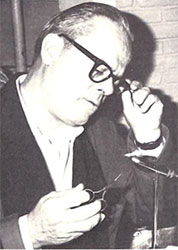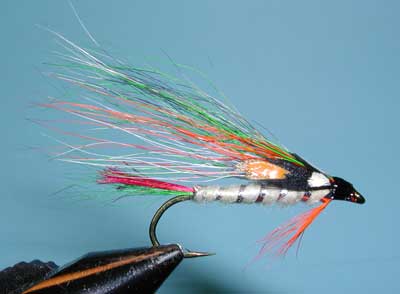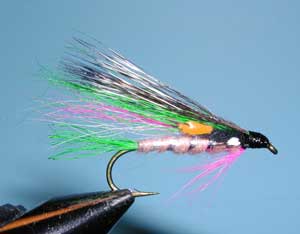Notes:
 This is a series of patterns originated by Samuel R. Slaymaker II of Gap, Pennsylvania in the late 1950's. Mr. Slaymaker studied the natural fry to create a natural looking imitation using dyed bucktail. The hairs that make up the wing are blended slightly. It is an effective fly for use on trout in sizes 6-12 for our Sierran waters using a stripping action. Mr. Slaymaker had an interesting history as an expert on such wide-ranging topics as private schools, European history and fly fishing. He wrote two books on fly fishing, Simplified Fly Fishing in 1969 and Tie a Fly, Catch a Fish in 1976. As an outdoors writer, he was a regular contributor to such magazines as Esquire, Outdoor Life, Field and Stream, and Sports Afield. He passed away in Lancaster, PA in April 11th, 1989 at the age of 66 years. This is a series of patterns originated by Samuel R. Slaymaker II of Gap, Pennsylvania in the late 1950's. Mr. Slaymaker studied the natural fry to create a natural looking imitation using dyed bucktail. The hairs that make up the wing are blended slightly. It is an effective fly for use on trout in sizes 6-12 for our Sierran waters using a stripping action. Mr. Slaymaker had an interesting history as an expert on such wide-ranging topics as private schools, European history and fly fishing. He wrote two books on fly fishing, Simplified Fly Fishing in 1969 and Tie a Fly, Catch a Fish in 1976. As an outdoors writer, he was a regular contributor to such magazines as Esquire, Outdoor Life, Field and Stream, and Sports Afield. He passed away in Lancaster, PA in April 11th, 1989 at the age of 66 years.
The first of this trio to be tied was the Little Brown trout (1958), followed by the Little Brook trout. The colors were decided by having a pair of small hatchery fish, a brook and a brown, cast into clear plastic resin. This could be manipulated to expose the different colors of the fish separately. Then the correct shade of material was chosen. In 1958, Samuel gave his Little Brown Trout streamer to a friend, John Stauffer, who caught a large Brown trout in Spring Creek, Centre County, Pennsylvania. Other prominent anglers such as Ernest Schweibert, John Alden Knight, and Arnold Gingrich took notice and Weber Tackle Company of Stevens Point, Wisconsin started to market the pattern in 1960. Samuel followed up with the Litte Brook trout and Little Rainbow trout in the early 1960's. |




